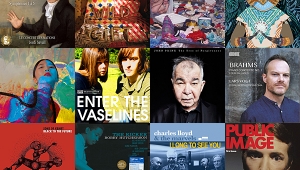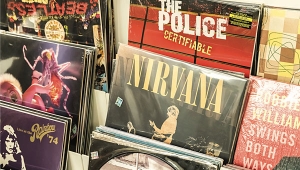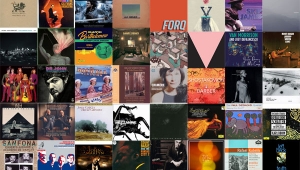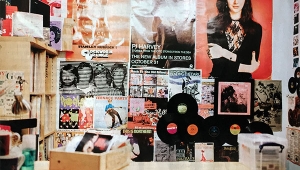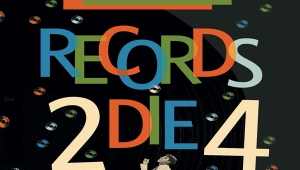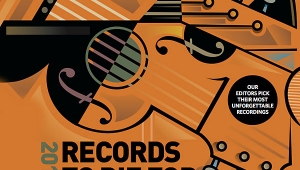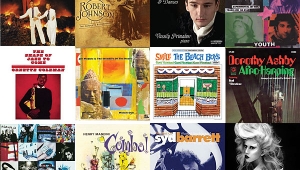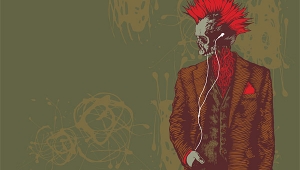| Columns Retired Columns & Blogs |
2004 Records To Die For Page 8
DAVID PATRICK STEARNS
RAVEL: Complete Works for Piano
Alexandre Tharaud, piano
Harmonia Mundi 901811.12 (2 CDs). 2003. Jean-Martial Golaz, prod., eng. DDD. TT: 2:00:18
Were Jean-Yves Thibaudet the best that the French piano school now has to offer, I'd require antidepressants that haven't yet been invented. Instead, there's Alexandre Tharaud, a name nearly unknown in the US aside from some Poulenc chamber-music CDs on Naxos and a Rameau disc on Harmonia Mundi. On the evidence of this newly released set, Tharaud is a major keyboard personality. His idol—suggested by both interviews and the dedication on his CD—is Marcelle Meyer, a pianistic deity who reigned in mid-20th-century Paris. Clearly, Tharaud is searching for values and manners that were lost in the internationalization of post-World War II France. The result is an adventurous, expansive, individualistic approach that yields a Gaspard de la Nuit as sexy as (but more tasteful than) Ivo Pogorelich's on DG. The resonant sound, which gives Ravel's colors needed breathing room, is a relief to those who have tired of airless, digitized piano recordings. Other Tharaud recordings indicate that while this Ravel set is his best recording so far, it's no fluke. A strong runner-up is Reynaldo Hahn's Quintet for Piano and String Quartet on Auvidis (V 4848).
J.S. BACH: English Suite No.6
BEETHOVEN: Piano Sonata 31, Op.110
WEBERN: Variations, Op.27
Piotr Anderszewski, piano
Accord 025 (CD). 1996. Lech Dudik, Gabriela Blicharz, prods. DDD. TT: 60:38
Early recordings by notable artists have a way of emerging like skeletons from the closet, as does this disc, made by Piotr Anderszewski before his 2002 Gilmore Artist Award. However, its bones don't rattle for the usual reasons. This disc—his first—hails from a period when Anderszewski was mainly known as Viktora Mullova's tousle-haired accompanist, and typically shows him playing repertoire that many artists save until they're 40. Also typically, he triumphs with technical crispness, intellectual precision, and clarity of vision. The embarrassing part is that these qualities are more evident here than in his subsequent discs. The Beethoven is astoundingly confident in its exploration of structural elements: Tricky modifications of tempo give this usually cerebral aspect of Beethoven a distinctive expressive tenderness. Also, you could have little sympathy for Webern and still have no problem tracking his thematic transformations in Anderszewski's reading. But good luck in finding this disc; my Polish pressing came from a second-hand store, and it appears to be out of print. Given Anderszewski's increasing visibility, it can't stay that way long.
RALPH LALAMA & HIS MANHATTAN ALL-STARS: Feelin' and Dealin'
Ralph LaLama, tenor sax; Tom Harrell, trumpet, flugelhorn; Barry Harris, piano; Peter Washington, bass; Kenny Washington, drums
Criss Cross 1046 (CD). 1990. Gerry Teekins, prod.; Max Bolleman, eng. DDD. TT: 55:35
For a look at how bebop evolved in the latter part of the 20th century, this 1990 date led by the unsung Ralph LaLama, known mainly through his years with the Vanguard Jazz Orchestra and a damn solid Bird-meets-Trane tenorman, is as good as it gets. The participants include diehard bopper pianist Barry Harris, trumpeter Tom Harrell (who knows almost as much Bird and Diz as Harris does), and the unrelated Washingtons Peter and Kenny, who supply a supple bottom. This crack team essays Elmo Hope's aptly named "So Nice," Thad Jones' delectable "Evol Deklaw Ni" (spell it backward), Bud Powell's slalom-like "Crazeology," Sonny Rollins' quietly surging "Paradox," and four other goodies, all with an élan befitting masters.
LEE MORGAN: The Sidewinder
Lee Morgan, trumpet; Joe Henderson, tenor sax; Barry Harris, piano; Bob Cranshaw, bass; Billy Higgins, drums
Blue Note 4 95332 2 (CD). 1963/1999. Alfred Lion, orig. prod.; Michael Cuscuna, reissue prod.; Rudy Van Gelder, eng., remastering. AAD. TT: 50:52
This one-size-fits-all album is a mix of blues, swing, funk, and melodic whammy that can appeal to someone who's never heard jazz, who's just getting into it, or who's a deeply devoted disciple or practitioner. It's acclaimed for the title track, a rumbling boogaloo that was the fiery Morgan's sole hit. It sports spiffy work from Morgan, tenor dynamo Joe Henderson, pianist Barry Harris, and the fluid-beat rhythm team of bassist Bob Cranshaw and amazing drummer Billy Higgins. The other tracks are even better. "Hocus Pocus" is a perky line built on the changes of "Mean to Me," "Gary's Notebook" and "Boy, What a Night" are two rhythmically intriguing blues variants, and "Totem Pole" slips and slides through two moods. Solos are succulent throughout.
VAN MORRISON: Veedon Fleece
Warner Bros. 2805-2 (CD). 1974. Van Morrison, prod.; Jim Stern, Dahaud & Jean Shaar, Elvin Campbell, engs. AAD. TT: 47:46
Van Morrison decided to be a poet, not a pop star, when he put together this album, which anticipated most of his subsequent greatest work. Veedon Fleece was an evocation of Morrison's personal Camelot, a place where Jackie Wilson and Cuchulain sat at the same table, a myth-infused mixture of ancient Irish airs and heaven-born rhythm and blues rhythms.
JELLO BIAFRA/MOJO NIXON & TOADLIQUORS: Prairie Home Invasion
Alternate Tentacles 137 (CD). 1994. Marshall Lawless, Tri-State Kill Spree Johnson, prods.; Stuart Sullivan, eng. ADD. TT: 54:30
This is probably the most subversive rock record made in the 1990s, a frenzied ride between the runaway horses of Dead Kennedys founder Jello Biafra and the avatar of political incorrectness, Mojo Nixon. Nixon's awesome band, the Toadliquors, featuring the great Pete (Wet Dawg) Gordon on keyboards, provides the appropriately maniacal tone for such gems as "Buy My Snake Oil," "Convoy in the Sky," "Atomic Power," "Let's Go Burn Ole Nashville Down," "Will the Fetus Be Aborted," and, of course, "Are You Drinkin' With Me Jesus." Topical news stories ("Beer spill kills fish"; "Country music causes suicide!") and Tom Tomorrow's This Modern World comic strips adorn the fun-packed insert booklet.
BARBER: Violin Concerto, Orchestral Music
Souvenirs (Ballet Suite), Serenade for Strings, Music for a Scene from Shelley
James Boswell, violin; Marin Alsop, Royal Scottish National Orchestra
Naxos 8.559004 (CD). 2001. Andrew Walton, prod.; Tony Faulkner, eng. DDD. TT: 64:20
Again, I'll take two from the Naxos American Classics series. Samuel Barber's Violin Concerto, which premiered in 1941, has long been one of the composer's most popular works, perhaps because Barber had to make it more glitzy—at the request of the premiere's intended soloist, Barber composed a strikingly brilliant finale. Nor did that version please the intended soloist, who found it "unplayably difficult." American violinist James Boswell here plays the unplayable on the Levêque Stradivarius of 1720. (Might as well give the instrument maker credit, too.) The chamber-like work is scored for just eight woodwinds, two horns, two trumpets, percussion, piano, and strings. The second movement opens with a magnificent oboe solo that's reminiscent of Brahms. A delightful surprise (for me) on this disc was Souvenirs, a ballet suite consisting of six short movements in different dance genres. Pas de Deux has some hauntingly beautiful instrumental solos, and wait till you hear Hesitation Tango, in which the full orchestral forces suddenly blaze forth in all their glory. Ah, that horn section of the Royal Scottish National Orchestra! A magnificent disc all around, with superb engineering by Tony Faulkner. And at a Naxos price!
ROREM: Symphonies 1-3
José Serebrier, Bournemouth Symphony Orchestra
Naxos 8.559149 (CD). 2003. Phil Rowlands, prod., eng.; Nick Parker, prod. DDD. TT: 69:22
Think of composer Ned Rorem and you think of songs. But Rorem has always composed orchestral music, too, including these three symphonies, composed between 1950 and 1958. Symphonies 1 and 2 receive their first recordings here, which is surprising considering the quality of the works. Or is it? Rorem was out of favor among conductors and critics because he avoided the atonal and the experimental. His music is melodic and songlike, sometimes haunting, sometimes playful. So much for giving concert audiences access to what they might find accessible. The strongest work here is Symphony 3. I especially admire the fourth movement, Andante, which starts off with a dreamy, pastoral English horn solo. Hats off to Naxos for yet another superb disc in their American Classics series. If I were a music critic, I'd call this disc "indispensable," the recording "unimpeachable."
TALLIS SCHOLARS: The Essential Tallis Scholars
The Tallis Scholars; Peter Phillips, cond.
Gimell CDGIM 201 (2 CDs). 2003. Steve C. Smith, Peter Phillips, prods.; Bob Auger, Tony Faulkner, Mike Clements, Philip Hobbs, engs. AAD/DDD. TT: 2:35:41
Of course, everyone knows that all Tallis Scholars recordings are essential—but this two-disc compilation makes an ideal companion when you don't have room to bring along all of the choir's 30-plus CDs, made during 15 years of recording. The carefully chosen program includes classics such as the Allegri Miserere, Tallis's O Nata Lux, and Byrd's five-part Mass.
VIVALDI: Sacred Music, Vol.9
Laudate pueri, Salve Regina, other works
The King's Consort, Choir of the King's Consort; Robert King, cond.
Hyperion CDA66839 (CD). 2003. Ben Turner, prod.; Philip Hobbs, eng. DDD. TT: 66:42
Everything here—music, singing, playing, and sound—is outstanding. But I treasure this disc for one reason: mezzo-soprano Joyce DiDonato. Her voice, and her singing of the motet Ascende Laeta, are literally to die for.
OH SUSANNA: Sleepy Little Sailor
Stella 3 (CD). 2001. Colin Cripps, prod. AAD. TT: 47:36. Available at www.ohsusannamusic.com.
Oh Susanna is the stage name of San Francisco-born, Vancouver-raised, Toronto-based singer-songwriter Susie Ungerleider. Recorded with friends at a lakeside house in Ontario, Sleepy Little Sailor blends family lore, childhood memories, adolescent exploration, and adult angst in haunting, bittersweet sonic dreamscapes that persist long after the music fades. Bearing the imprimatur of the Ontario Arts Council, the disc is proof that big things are possible on modest budgets—the songwriting, musicianship, and sound are equally superb. Sleepy Little Sailor has been in near-constant rotation chez nous since it was first released three years ago.
CHARLIE TAYLOR: Once Upon a Time
Rhombus 8016 (CD). 2003. Dan Penn, Geoff Gillette, prods., engs.; Ron Laury, eng. AAD. TT: 51:07. Available at www.charlietaylormusic.com.
Anyone who's lived in the South will find Charlie Taylor's music as comfortable as a favorite old pair of sneakers. Polished but unpretentious, these tunes evoke hot clubs, steamy streets, boss rides, balmy nights, and cool coastal breezes. The Nashville singer-songwriter assembled an all-star team for this project, including vocalist Jimmy Griffin, violinist Kristin Koval, drummers Ian Wallace and Daniel Tashian, songwriter-keyboardists Spooner Oldham and Carson Whitsett, bassists Mike Leech and Ross Sermons, and guitarists Scotty Moore, Rick Vito, Barry Tashian, and Mike Duhham. Taylor has diligently honed his craft over decades. It was therefore exceptionally gratifying that this inaugural release got short-listed recently by the Grammy organization.
RAVEL: Complete Works for Piano
Alexandre Tharaud, piano
Harmonia Mundi 901811.12 (2 CDs). 2003. Jean-Martial Golaz, prod., eng. DDD. TT: 2:00:18
Were Jean-Yves Thibaudet the best that the French piano school now has to offer, I'd require antidepressants that haven't yet been invented. Instead, there's Alexandre Tharaud, a name nearly unknown in the US aside from some Poulenc chamber-music CDs on Naxos and a Rameau disc on Harmonia Mundi. On the evidence of this newly released set, Tharaud is a major keyboard personality. His idol—suggested by both interviews and the dedication on his CD—is Marcelle Meyer, a pianistic deity who reigned in mid-20th-century Paris. Clearly, Tharaud is searching for values and manners that were lost in the internationalization of post-World War II France. The result is an adventurous, expansive, individualistic approach that yields a Gaspard de la Nuit as sexy as (but more tasteful than) Ivo Pogorelich's on DG. The resonant sound, which gives Ravel's colors needed breathing room, is a relief to those who have tired of airless, digitized piano recordings. Other Tharaud recordings indicate that while this Ravel set is his best recording so far, it's no fluke. A strong runner-up is Reynaldo Hahn's Quintet for Piano and String Quartet on Auvidis (V 4848).
J.S. BACH: English Suite No.6
BEETHOVEN: Piano Sonata 31, Op.110
WEBERN: Variations, Op.27
Piotr Anderszewski, piano
Accord 025 (CD). 1996. Lech Dudik, Gabriela Blicharz, prods. DDD. TT: 60:38
Early recordings by notable artists have a way of emerging like skeletons from the closet, as does this disc, made by Piotr Anderszewski before his 2002 Gilmore Artist Award. However, its bones don't rattle for the usual reasons. This disc—his first—hails from a period when Anderszewski was mainly known as Viktora Mullova's tousle-haired accompanist, and typically shows him playing repertoire that many artists save until they're 40. Also typically, he triumphs with technical crispness, intellectual precision, and clarity of vision. The embarrassing part is that these qualities are more evident here than in his subsequent discs. The Beethoven is astoundingly confident in its exploration of structural elements: Tricky modifications of tempo give this usually cerebral aspect of Beethoven a distinctive expressive tenderness. Also, you could have little sympathy for Webern and still have no problem tracking his thematic transformations in Anderszewski's reading. But good luck in finding this disc; my Polish pressing came from a second-hand store, and it appears to be out of print. Given Anderszewski's increasing visibility, it can't stay that way long.
ZAN STEWART
RALPH LALAMA & HIS MANHATTAN ALL-STARS: Feelin' and Dealin'
Ralph LaLama, tenor sax; Tom Harrell, trumpet, flugelhorn; Barry Harris, piano; Peter Washington, bass; Kenny Washington, drums
Criss Cross 1046 (CD). 1990. Gerry Teekins, prod.; Max Bolleman, eng. DDD. TT: 55:35
For a look at how bebop evolved in the latter part of the 20th century, this 1990 date led by the unsung Ralph LaLama, known mainly through his years with the Vanguard Jazz Orchestra and a damn solid Bird-meets-Trane tenorman, is as good as it gets. The participants include diehard bopper pianist Barry Harris, trumpeter Tom Harrell (who knows almost as much Bird and Diz as Harris does), and the unrelated Washingtons Peter and Kenny, who supply a supple bottom. This crack team essays Elmo Hope's aptly named "So Nice," Thad Jones' delectable "Evol Deklaw Ni" (spell it backward), Bud Powell's slalom-like "Crazeology," Sonny Rollins' quietly surging "Paradox," and four other goodies, all with an élan befitting masters.
LEE MORGAN: The Sidewinder
Lee Morgan, trumpet; Joe Henderson, tenor sax; Barry Harris, piano; Bob Cranshaw, bass; Billy Higgins, drums
Blue Note 4 95332 2 (CD). 1963/1999. Alfred Lion, orig. prod.; Michael Cuscuna, reissue prod.; Rudy Van Gelder, eng., remastering. AAD. TT: 50:52
This one-size-fits-all album is a mix of blues, swing, funk, and melodic whammy that can appeal to someone who's never heard jazz, who's just getting into it, or who's a deeply devoted disciple or practitioner. It's acclaimed for the title track, a rumbling boogaloo that was the fiery Morgan's sole hit. It sports spiffy work from Morgan, tenor dynamo Joe Henderson, pianist Barry Harris, and the fluid-beat rhythm team of bassist Bob Cranshaw and amazing drummer Billy Higgins. The other tracks are even better. "Hocus Pocus" is a perky line built on the changes of "Mean to Me," "Gary's Notebook" and "Boy, What a Night" are two rhythmically intriguing blues variants, and "Totem Pole" slips and slides through two moods. Solos are succulent throughout.
JOHN SWENSON
VAN MORRISON: Veedon Fleece
Warner Bros. 2805-2 (CD). 1974. Van Morrison, prod.; Jim Stern, Dahaud & Jean Shaar, Elvin Campbell, engs. AAD. TT: 47:46
Van Morrison decided to be a poet, not a pop star, when he put together this album, which anticipated most of his subsequent greatest work. Veedon Fleece was an evocation of Morrison's personal Camelot, a place where Jackie Wilson and Cuchulain sat at the same table, a myth-infused mixture of ancient Irish airs and heaven-born rhythm and blues rhythms.
Side 1 of the original LP ("Fair Play" to "You Don't Pull No Punches, But You Don't Push the River") is a magnificent suite that rivals Astral Weeks for sheer lyricism. Morrison hits incredibly sweet high notes on "Who Was That Masked Man," and chants "our souls were clean and the grass did grow" to ethereal pennywhistle accompaniment on "Streets of Arklow." "...River" is a trance masterpiece that uses the chords of Dylan's "All Along the Watchtower" and the rhythmic pulse of James Brown's "Doin' It to Death" to arrive at a musical statement that is pure Van Morrison.
JELLO BIAFRA/MOJO NIXON & TOADLIQUORS: Prairie Home Invasion
Alternate Tentacles 137 (CD). 1994. Marshall Lawless, Tri-State Kill Spree Johnson, prods.; Stuart Sullivan, eng. ADD. TT: 54:30
This is probably the most subversive rock record made in the 1990s, a frenzied ride between the runaway horses of Dead Kennedys founder Jello Biafra and the avatar of political incorrectness, Mojo Nixon. Nixon's awesome band, the Toadliquors, featuring the great Pete (Wet Dawg) Gordon on keyboards, provides the appropriately maniacal tone for such gems as "Buy My Snake Oil," "Convoy in the Sky," "Atomic Power," "Let's Go Burn Ole Nashville Down," "Will the Fetus Be Aborted," and, of course, "Are You Drinkin' With Me Jesus." Topical news stories ("Beer spill kills fish"; "Country music causes suicide!") and Tom Tomorrow's This Modern World comic strips adorn the fun-packed insert booklet.
SAM TELLIG
BARBER: Violin Concerto, Orchestral Music
Souvenirs (Ballet Suite), Serenade for Strings, Music for a Scene from Shelley
James Boswell, violin; Marin Alsop, Royal Scottish National Orchestra
Naxos 8.559004 (CD). 2001. Andrew Walton, prod.; Tony Faulkner, eng. DDD. TT: 64:20
Again, I'll take two from the Naxos American Classics series. Samuel Barber's Violin Concerto, which premiered in 1941, has long been one of the composer's most popular works, perhaps because Barber had to make it more glitzy—at the request of the premiere's intended soloist, Barber composed a strikingly brilliant finale. Nor did that version please the intended soloist, who found it "unplayably difficult." American violinist James Boswell here plays the unplayable on the Levêque Stradivarius of 1720. (Might as well give the instrument maker credit, too.) The chamber-like work is scored for just eight woodwinds, two horns, two trumpets, percussion, piano, and strings. The second movement opens with a magnificent oboe solo that's reminiscent of Brahms. A delightful surprise (for me) on this disc was Souvenirs, a ballet suite consisting of six short movements in different dance genres. Pas de Deux has some hauntingly beautiful instrumental solos, and wait till you hear Hesitation Tango, in which the full orchestral forces suddenly blaze forth in all their glory. Ah, that horn section of the Royal Scottish National Orchestra! A magnificent disc all around, with superb engineering by Tony Faulkner. And at a Naxos price!
ROREM: Symphonies 1-3
José Serebrier, Bournemouth Symphony Orchestra
Naxos 8.559149 (CD). 2003. Phil Rowlands, prod., eng.; Nick Parker, prod. DDD. TT: 69:22
Think of composer Ned Rorem and you think of songs. But Rorem has always composed orchestral music, too, including these three symphonies, composed between 1950 and 1958. Symphonies 1 and 2 receive their first recordings here, which is surprising considering the quality of the works. Or is it? Rorem was out of favor among conductors and critics because he avoided the atonal and the experimental. His music is melodic and songlike, sometimes haunting, sometimes playful. So much for giving concert audiences access to what they might find accessible. The strongest work here is Symphony 3. I especially admire the fourth movement, Andante, which starts off with a dreamy, pastoral English horn solo. Hats off to Naxos for yet another superb disc in their American Classics series. If I were a music critic, I'd call this disc "indispensable," the recording "unimpeachable."
DAVID VERNIER
TALLIS SCHOLARS: The Essential Tallis Scholars
The Tallis Scholars; Peter Phillips, cond.
Gimell CDGIM 201 (2 CDs). 2003. Steve C. Smith, Peter Phillips, prods.; Bob Auger, Tony Faulkner, Mike Clements, Philip Hobbs, engs. AAD/DDD. TT: 2:35:41
Of course, everyone knows that all Tallis Scholars recordings are essential—but this two-disc compilation makes an ideal companion when you don't have room to bring along all of the choir's 30-plus CDs, made during 15 years of recording. The carefully chosen program includes classics such as the Allegri Miserere, Tallis's O Nata Lux, and Byrd's five-part Mass.
VIVALDI: Sacred Music, Vol.9
Laudate pueri, Salve Regina, other works
The King's Consort, Choir of the King's Consort; Robert King, cond.
Hyperion CDA66839 (CD). 2003. Ben Turner, prod.; Philip Hobbs, eng. DDD. TT: 66:42
Everything here—music, singing, playing, and sound—is outstanding. But I treasure this disc for one reason: mezzo-soprano Joyce DiDonato. Her voice, and her singing of the motet Ascende Laeta, are literally to die for.
BARRY WILLIS
OH SUSANNA: Sleepy Little Sailor
Stella 3 (CD). 2001. Colin Cripps, prod. AAD. TT: 47:36. Available at www.ohsusannamusic.com.
Oh Susanna is the stage name of San Francisco-born, Vancouver-raised, Toronto-based singer-songwriter Susie Ungerleider. Recorded with friends at a lakeside house in Ontario, Sleepy Little Sailor blends family lore, childhood memories, adolescent exploration, and adult angst in haunting, bittersweet sonic dreamscapes that persist long after the music fades. Bearing the imprimatur of the Ontario Arts Council, the disc is proof that big things are possible on modest budgets—the songwriting, musicianship, and sound are equally superb. Sleepy Little Sailor has been in near-constant rotation chez nous since it was first released three years ago.
CHARLIE TAYLOR: Once Upon a Time
Rhombus 8016 (CD). 2003. Dan Penn, Geoff Gillette, prods., engs.; Ron Laury, eng. AAD. TT: 51:07. Available at www.charlietaylormusic.com.
Anyone who's lived in the South will find Charlie Taylor's music as comfortable as a favorite old pair of sneakers. Polished but unpretentious, these tunes evoke hot clubs, steamy streets, boss rides, balmy nights, and cool coastal breezes. The Nashville singer-songwriter assembled an all-star team for this project, including vocalist Jimmy Griffin, violinist Kristin Koval, drummers Ian Wallace and Daniel Tashian, songwriter-keyboardists Spooner Oldham and Carson Whitsett, bassists Mike Leech and Ross Sermons, and guitarists Scotty Moore, Rick Vito, Barry Tashian, and Mike Duhham. Taylor has diligently honed his craft over decades. It was therefore exceptionally gratifying that this inaugural release got short-listed recently by the Grammy organization.
- Log in or register to post comments

